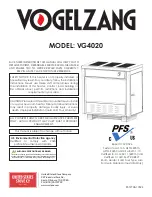
9
8. COMBUSTION PRINCIPLE
This stove was developed for semi-slow burning. Loaded fully with wood and operating on a
slow burn the stove will burn through the night with sufficient embers left over the next day to
relight the fire.
It is also possible to set the stove to a very slow burn (no flames).
We do not recommend this for the following reasons:
a) it causes insufficient burning which pollutes the air extremely heavily and unnecessarily
b) this inadequate burning gives rise to extra smoke which deposits tar on the sides of the
stove, the flue and the window when condensing. An accumulation of tar is not only
unsightly but requires regular cleaning of the flue to prevent a chimney fire.
If you are burning damp or green wood the combustion air regulator must be sufficiently open
to obtain a good flame (see next page).
HEAT EMISSION:
the stove gives off two types of heat:
a) heat emission by radiance.
Heat radiates in a straight line from a hot surface. Besides the fire, the main sources of
heat radiation are the hot ashes and the vermiculite sides covering the stove. This radiation
is sent out into the room via the window and heats the immediate environment of the stove.
b) heat emission by convection.
Heat convection occurs when air in contact with a hot surface rises.
Cold air enters the stove via the air inlet (A). This air passes over the bottom of the stove,
then via the back to the ceiling of the combustion chamber before exiting via the hot air
outlet (B).
Summary of Contents for SORDO 80 Flatline
Page 14: ...14...



































